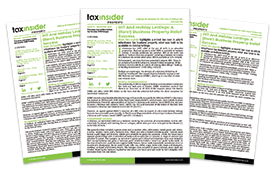Before you go, sign up to our free tax saving email course. Get 7 top property tax saving strategies in your email inbox that will help you save thousands in tax. Unsubscribe any time.
|
The capital gains tax (CGT) annual exemption is a welcome and useful tax break for many taxpayers. It is generally available to individuals (i.e. £12,000 for 2019/20), personal representatives (for the tax year of death and the two following years) and trustees (albeit the maximum entitlement is generally one-half of the exemption for individuals; see TCGA 1992, Sch 1C). This article focuses on individuals. Don’t waste it! The CGT annual exemption is a ‘use it or lose it’ allowance, in the sense that any unused exemption for one tax year cannot be carried forward (although it can be carried back to a limited extent on death). Tax planning involving the CGT annual exemption is often aimed at ensuring that multiple exemptions are used in respect of the same asset (e.g. an investment property) standing at a gain. There are two main methods in practice: 1. Disposing of the asset in stages over two or more tax years, so that the gains falling into each tax year are reduced by the annual exemption for that year (what HM Revenue and Customs (HMRC) refers to as ‘fragmentation’). This may happen where an interest in the investment property is transferred from (say) parent to adult child in one tax year, and a further interest in the property is transferred in the following tax year. 2. Gifting parts of an asset (commonly a business asset on which gift holdover relief can be claimed) to (say) other family members such as spouses (or civil partners) and children prior to disposal of the asset, so that each individual can use their annual exemptions to reduce the overall CGT liability (what HMRC refers to as ‘asset splitting’). However, note that gains on investment properties cannot be ‘held over’ in this way (unless they are qualifying furnished holiday lettings). HMRC’s view HMRC is alert to the use of the annual exemption as an ‘avoidance device’. HMRC’s guidance accepts (in its Capital Gains manual at CG18150) that not every ‘fragmented’ disposal is for tax avoidance purposes, and that a gift may be genuine even though there is an overall tax benefit. However, HMRC may challenge artificial arrangements by opening an enquiry into the tax return of the person(s) making the disposal. For example, HMRC might look at the disposal of an asset where it suspects that an unconditional contract for its sale took place before an interest in the asset was gifted. Alternatively, HMRC may seek to contend that a gift was a ‘sham’. Information and documentation to support transactions (e.g. correspondence, contracts) should be retained for possible inspection. Practical tip HMRC’s guidance on the exploitation of the annual exemption concludes: ‘When considering any challenge to any arrangements you should also give consideration to the amount of tax at risk.’ The potential tax savings vary. For individuals, the normal CGT rates (for 2019/20) are 10% (basic rate taxpayer) and/or 20% (higher rate taxpayer). However, those rates are increased to 18% and 28% in respect of residential property and carried interest. The possible tax savings (for 2019/20) therefore range from £1,200 to £3,360. This is a sample article from the monthly Property Tax Insider magazine. Go here to get your first free issue of Property Tax Insider. |


 Tax Articles
Tax Articles
 Mark McLaughlin looks at planning using the capital gains tax annual exemption.
Mark McLaughlin looks at planning using the capital gains tax annual exemption.